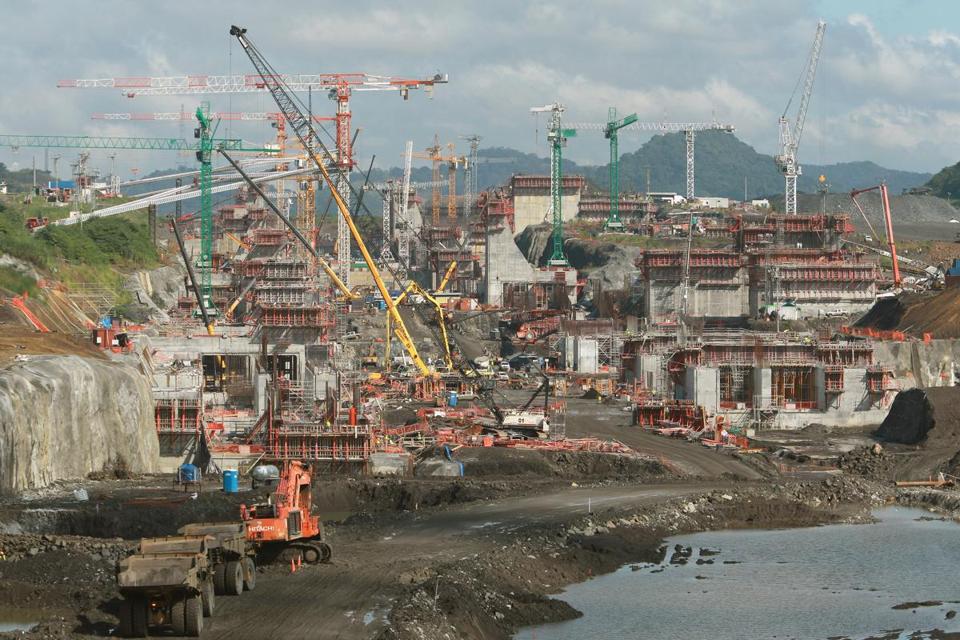Unless you have been living under a rock for the last few years, you are aware that Panama is expanding the canal to accommodate larger vessels. Besides just being wider, these ships have drafts that require a 50 foot deep canal. As with the canal, ports around the world are having to scramble to do the same thing if they want to compete in a global economy. This post is the first of a few that I am doing to cover events leading up to the opening in 2015.
This is a great opener from the Boston Globe Columnist Juliette Kayyem. Be sure to click on the link below to see related photos that are great.
Panama’s magic number
A 50-feet deep canal is the only way to compete in global shipping
PANAMA CITY
Rodolfo R. Sabonge, a vice president of the Panama Canal Authority, sits in his office before a 30-foot map of the world. It isn’t the land that interests him, but the water. A huge glass window overlooks the canal that is his livelihood and his country’s future. The scene is the chaotic combination of destruction and construction that marks any massive project, midstream. The authority is overseeing the multi-billion-dollar expansion of the canal to make it wider and deeper so that larger boats can pass through.
Sabonge talks less about Panama than about other ports that will benefit from the new throughway. The canal, he knows, is just a means to an end, a shortcut from Point A to Point B, connecting two oceans. But where is Point B? US ports are scrambling for that distinction, as Northeastern and Southern states vie to be the destination point for the giant “post-Panamax” freighters that will carry goods from Asia directly to and from the East Coast of the United States. Panama’s expansion will serve to increase the size of vessels “whether US ports are ready or not,” Sabonge jokingly warns.
In the competitive shipping industry, there is a lot of talk about numbers: US imports and exports account for trillions of dollars, billions in shipping taxes are collected by states and localities, and US ports employ more than 3 million people. But there is only one metric that matters to ports east of the Mississippi: 50.
“Fifty is the magic number,” a Coast Guard official told me. That is the depth in feet needed for a port to be able to successfully receive the post-Panamax ships that will, within 20 years, carry the vast majority of global commerce. Many ports that now rest at 43 to 45 feet are digging and dredging to get there; Norfolk, Va., is ready, as is Baltimore. New York and New Jersey are hoping, but they have to elevate the Bayonne Bridge near Staten Island to make it happen. Boston would have a long way to dig.
The United States is the only modern society that does not have a federal agency responsible for port strategy. Maritime planning is left to the states. The White House can merely promise expedited engineering review, as it did last month, of the port changes in New York, New Jersey, South Carolina, Georgia, and Florida, all trying to get to that depth of 50 feet, fast.
This port competition marks the end of an empire, the West Coast Empire, which has benefitted from container traffic that can’t currently fit through the canal; post-Panamax ships that cross the Pacific Ocean must now offload their cargo on the West Coast, from which it moves across the country on a “land bridge” of highways and railways. According to a 2008 study, nearly 30 percent of containers coming to New England begin their transcontinental journey from the ports of Los Angeles and Long Beach.
After the Panama Canal’s expansion, the largest container ships will be able to steam straight through to the East Coast, cutting costs dramatically. It will finally enable ports along the East Coast and Gulf of Mexico to be major players in global commerce.
Smaller ports like Boston will benefit even if they can’t commit to a depth of 50 feet. (Boston is, according to a June 2012 study by the US Army Corps of Engineers, at 40 feet.) Massport is expanding the Conley Container Terminal in anticipation, because smaller ships displaced by the bigger ones will still need ports to come ashore. And, inevitably, some of the post-Panamax boats will offload their cargo at new distribution hubs in places like the Bahamas, from which it will be loaded onto smaller cargo ships for the trip up the East Coast, in a process known as transshipment.
Over time, the shipping lanes that carry grain and cheap toys and oil and high fashion are going to move, inexorably, to the Atlantic. As the Panama Canal expansion proves, water — as a means of transport — has ripple effects from Saigon to Savannah, from the Bahamas to Boston. As the massive map in Sabonge’s office so clearly shows, the world is, above all things, wet.

